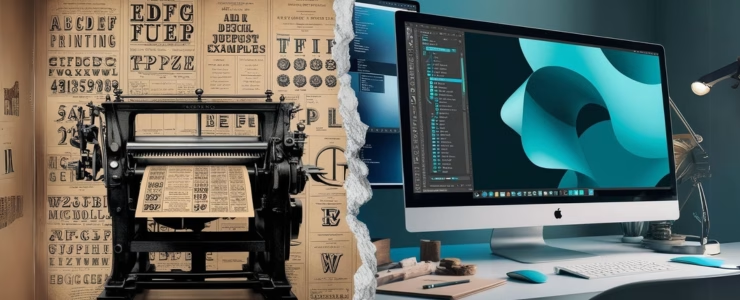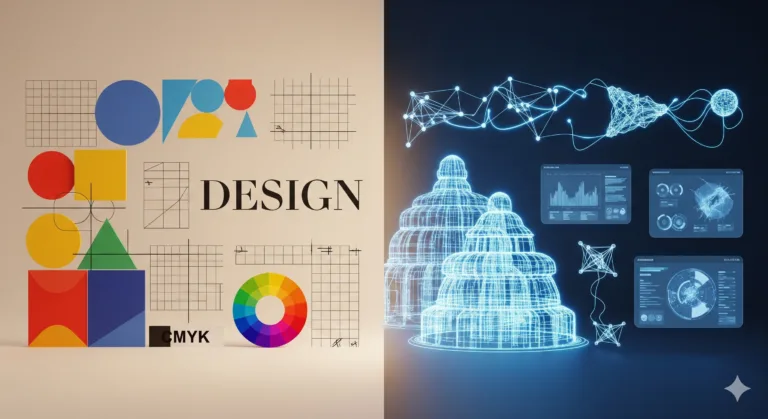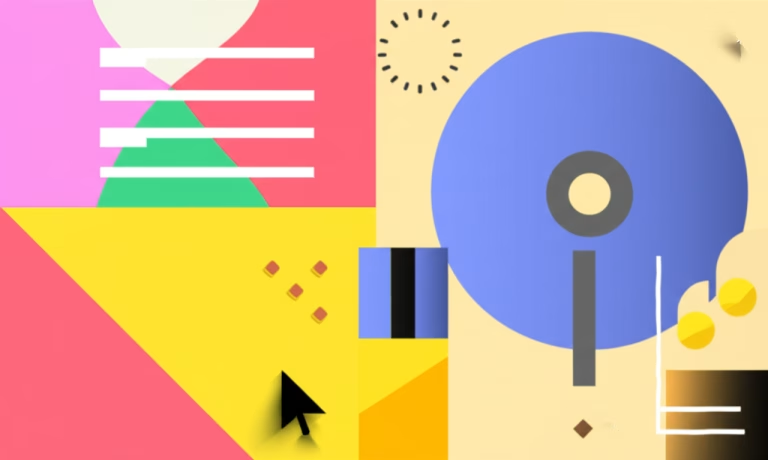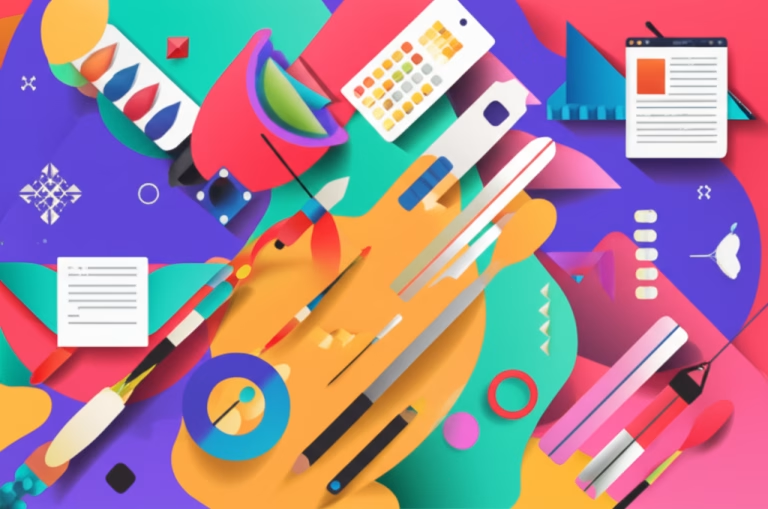Graphic design, a discipline that permeates our daily lives, is much more than simply “making things look pretty.” It is a form of visual communication, a universal language that transcends cultural and linguistic barriers. But, ultimately, what is graphic design at its core? This article seeks to demystify this multifaceted area, exploring its fundamental concepts, its rich history, its diverse applications, and the paths for those who wish to enter this creative and strategic world. If you dream of embarking on the design journey, this is your starting point.
Table of Contents
1. The Essence of Graphic Design: Effective Visual Communication
To understand what is graphic design, it is crucial to go beyond superficial aesthetics. At its root, graphic design is a tool for visual communication. Its primary goal is to convey messages, ideas, and information clearly, concisely, and attractively. A graphic designer uses visual elements – such as colors, typography, images, and layouts – to create pieces that not only please the eye but also fulfill a specific communicative purpose.
Purposeful Communication: Graphic design does not exist in a vacuum. Each piece, whether a logo, a website, or an advertisement, is designed with a target audience in mind and a clear objective to be achieved. This involves a deep understanding of the client’s needs, the context in which the piece will be used, and the message to be conveyed.
Organization and Structure: Good graphic design is that which organizes information logically and hierarchically, guiding the viewer’s eye in an intuitive way. Elements such as spacing, alignment, and contrast are used to create clarity and facilitate understanding.
Impact and Emotion: In addition to clarity, graphic design also seeks to generate impact and provoke emotions in the audience. The choice of colors, typography, and images can evoke different feelings and associations, influencing how the message is perceived.
Problem Solving: Graphic design is, at its core, a problem-solving activity. Designers are constantly challenged to find creative solutions to their clients’ communication challenges, whether related to branding, marketing, or user experience.
The Bridge Between Art and Functionality: Although there is an artistic aspect to design, it is not just art. Graphic design combines art and functionality, seeking to express a visually interesting message that works well in its context.
2. Graphic Design Concepts: Essential Fundamentals
To venture into the world of design, it is essential to master the graphic design concepts that form the basis of this discipline. These concepts, like the grammar of a language, are the pillars that support the creation of effective and memorable visual pieces.
Typography: The art and technique of arranging type to make written language legible, readable, and appealing. It involves the selection of fonts, the adjustment of spacing between letters (kerning), lines (leading), and words. Typography is not merely the choice of a font; it is an expressive element that conveys personality and tone of voice to the message.
Practical Example: The choice of a classic serif font for a history book evokes tradition and solemnity, while a modern sans-serif font for a technology application suggests innovation and dynamism.
Colors: Powerful elements that influence emotions and associations. Color theory explores the relationship between colors and their meanings, such as warm colors (red, yellow, orange), which suggest energy and passion, and cool colors (blue, green, purple), which convey calm and serenity. Color harmony and contrast are crucial for creating visually pleasing and effective compositions.
Practical Example: The use of vibrant colors in an advertising campaign for a children’s product attracts attention and conveys joy, while neutral colors on a corporate website communicate professionalism and seriousness.
Layout and Composition: The organization and arrangement of visual elements in a space. A good layout considers the hierarchy of information, visual flow, and balance, using elements such as grids, alignment, and proximity to create a coherent and functional composition.
Practical Example: In a flyer, the use of a well-defined grid organizes the text and images logically, facilitating the reading and understanding of the message.
Visual Hierarchy: The order of importance of elements in a composition. Visual hierarchy is created by varying size, color, contrast, and spacing, guiding the viewer’s eye to the most relevant information.
Practical Example: On a newspaper page, the main headline is presented in a larger and more prominent font than the body text, indicating its priority in reading.
White Space (Negative Space): The empty areas around design elements. White space is as important as the elements themselves, as it creates visual breathing room, improves readability, and allows elements to stand out.
Practical Example: In a minimalist logo, the strategic use of white space enhances the shape and message, avoiding visual pollution.
Images and Illustrations: Visual elements that enrich communication. The choice of appropriate images and illustrations, with high quality and resolution, is crucial to convey the desired message effectively.
Practical Example: In a travel advertisement, a photograph of a paradisiacal place awakens the desire and curiosity of the public, while a didactic illustration in a science book facilitates the understanding of complex concepts.
3. Foundations of Design: The Basis for Creativity
The foundations of design are principles that, applied in any area of design, help to create harmonious and effective compositions. These foundations, often interconnected, are the basis for creativity and innovation.
Unity: The feeling that all design elements belong to the same piece, creating a sense of harmony and cohesion. Unity is achieved through repetition, proximity, continuity, and alignment.
Practical Example: In a product catalog, the use of a color and typography pattern unifies the pages, creating a sense of belonging.
Balance: The distribution of visual weight in a composition. Balance can be symmetrical (elements distributed equally on both sides of a central axis) or asymmetrical (elements distributed unequally, but balanced by other elements).
Practical Example: On a poster, symmetrical balance creates a sense of stability and formality, while asymmetrical balance gives dynamism and movement.
Contrast: The visual difference between elements, such as colors, sizes, or shapes. Contrast is used to create focal points, generate visual interest, and improve readability.
Practical Example: The use of light and dark colors in text creates contrast, making reading easier, while the contrast between a large and a small element draws attention to the larger element.
Rhythm: The repetition of visual elements in a composition, creating a pattern or a flow. Rhythm can be regular (elements repeated at equal intervals) or irregular (elements repeated at varying intervals).
Practical Example: In a fabric pattern, the repetition of a floral motif creates a pleasing visual rhythm, while the irregular rhythm of geometric shapes in an abstract painting gives dynamism and movement.
Scale and Proportion: The size relationship between elements and the size relationship between elements and the total space. Scale and proportion are used to create visual hierarchy, impact, and realism.
Practical Example: On a map, the scale indicates the size relationship between the map and the real terrain, while the proportion between the elements allows the information to be understood correctly.
4. Areas of Graphic Design: A Universe of Possibilities
Graphic design encompasses a vast range of areas of activity, each with its peculiarities and challenges. This diversity allows designers to specialize in areas that correspond to their interests and talents.
Visual Identity (Branding): Creation of logos, color palettes, typography, and other visual elements that define the identity of a brand. Branding is essential to build a strong and recognizable image for companies and products.
Case Study: Apple, with its minimalist logo and clean visual language, has built one of the most valuable brands in the world, with a visual identity that evokes innovation and sophistication.
Editorial Design: Creation of magazines, newspapers, books, and other printed materials. Editorial design involves developing attractive and functional layouts, choosing appropriate typography, and organizing information clearly and hierarchically.
Practical Example: Magazines like National Geographic use editorial design to present informative and visually appealing content, with high-quality photos and sophisticated layouts.
Packaging Design: Creation of product packaging, considering aspects such as aesthetics, functionality, safety, and relevant information for the consumer. Packaging design is crucial to attract public attention at the point of sale and communicate the benefits of the product.
Case Study: The iconic packaging of Coca-Cola, with its contoured bottle and red label, has become a global symbol, recognized and loved by millions of people.
Web Design: Creation of websites and digital interfaces, considering aspects such as usability, accessibility, responsive design, and user experience (UX). Web design seeks to create websites that are visually appealing and fulfill their purpose efficiently.
Practical Example: Google, with its clean and minimalist interface, is an example of web design that values usability and ease of navigation.
Motion Graphics: Creation of animations and videos with moving graphic elements. Motion graphics are used in explanatory videos, vignettes, commercials, and other formats that combine text, image, and movement.
Practical Example: Explanatory videos of products or services, with fluid animations and clear information, have become increasingly popular, using motion graphics as a communication tool.
Illustration: Creation of original images for various purposes, such as books, magazines, packaging, websites, and advertising. Illustration allows ideas to be expressed creatively and personally, adding a unique touch to the design.
Practical Example: Children’s books, which often combine expressive illustrations with playful texts, use the power of illustration to enchant and educate children.
Signage: Creation of signs, panels, and other visual elements that guide and inform people in public and private spaces. Signage seeks to create clear and accessible messages, facilitating navigation and understanding of the environment.
Practical Example: Traffic signs, with their universal symbols and contrasting colors, are an example of effective signage that ensures safety and traffic organization.
5. The History of Graphic Design: A Fascinating Journey
The history of graphic design is a fascinating journey that accompanies the evolution of visual communication throughout the centuries. From the beginnings of writing to the digital age, graphic design has undergone several transformations, influenced by technological advances, artistic movements, and cultural changes.
Prehistory and Writing: Cave paintings and Egyptian hieroglyphs are prime examples of visual communication, demonstrating the human desire to record and transmit information through images.
The Invention of Printing: Gutenberg’s movable type press in the 15th century revolutionized the production of books and other printed materials, starting the era of mass communication and the need for visual organization of pages.
The Arts and Crafts Movement: In the 19th century, this movement valued handcrafted work and medieval aesthetics, seeking a counterpoint to mass industrial production and the pursuit of standardization.
The Bauhaus and Functionalism: In the early 20th century, the Bauhaus school in Germany advocated the union between art and industry, promoting functional design and the use of geometric shapes and primary colors.
The Era of Advertising and Marketing: With the growth of industry and consumption, graphic design gained prominence in the creation of advertisements, posters, and other advertising pieces, with the aim of attracting public attention and persuading purchases.
Graphic Design in the Digital Age: The rise of the internet and computers transformed graphic design, opening up new possibilities and challenges. Digital design became essential in the creation of websites, applications, and other digital interfaces.
Continuous Evolution: Graphic design continues to evolve, driven by new technologies and changes in society. The search for creative and innovative solutions is constant, and designers are increasingly valued for their ability to communicate and evoke emotions through visual language.
6. Getting Started in Graphic Design: Tips for Aspiring Designers
Entering the world of graphic design requires dedication, study, and constant practice. For aspiring designers, some tips can be valuable to begin this journey:
Invest in Education: Look for courses, workshops, and graphic design programs at recognized educational institutions. A solid education is essential to acquire the necessary theoretical and practical knowledge.
Master Design Tools: Familiarize yourself with software such as Adobe Photoshop, Illustrator, and InDesign, which are the main work tools of graphic designers.
Create a Portfolio: Start creating design pieces, even if they are personal projects. A portfolio is essential to showcase your skills and style to potential clients and employers.
Learn from the Best: Be inspired by renowned designers and analyze their work. Study their compositions, choice of colors, and typography, and try to apply this knowledge in your own projects.
Stay Up-to-Date: Graphic design is constantly evolving, so it is essential to keep up with trends, new technologies, and changes in the market.
Develop Your Critical Eye: Learn to evaluate your work and the work of others with a critical eye, identifying strengths and areas that need improvement.
Be Curious and Experiment: Explore different areas of graphic design, experiment with new techniques and software, and don’t be afraid to make mistakes. Experimentation is fundamental to the creative process.
Build Your Network: Participate in industry events, meet other designers, and build a network of contacts. Networking can open doors to new job opportunities.
Be Patient and Persistent: Learning graphic design is an ongoing process. Don’t get discouraged by the difficulties, and keep practicing and improving your skills.
Seek Feedback: Ask other designers for feedback on your work. Constructive feedback is essential to identify your strengths and areas that need development.
Conclusion
Graphic design is a vast and fascinating field that offers countless possibilities for those who want to express their creativity, communicate ideas, and solve problems through visual language. If you have a passion for design, dedication, and curiosity, the world of graphic design is waiting for you. Start your journey today and turn your vision into reality!
Now that you know the basics of design, it’s worth checking out our article “Common Mistakes of Beginners in Graphic Design and How to Avoid Them” to avoid common mistakes made by beginners in design. Another suggestion is to read the book “The Non-Designer’s Design Book” available on Amazon.



